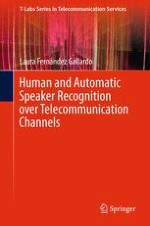2016 | OriginalPaper | Chapter
5. Automatic Speaker Verification Performance Under Channel Distortions
Author : Laura Fernández Gallardo
Published in: Human and Automatic Speaker Recognition over Telecommunication Channels
Publisher: Springer Singapore
Activate our intelligent search to find suitable subject content or patents.
Select sections of text to find matching patents with Artificial Intelligence. powered by
Select sections of text to find additional relevant content using AI-assisted search. powered by
